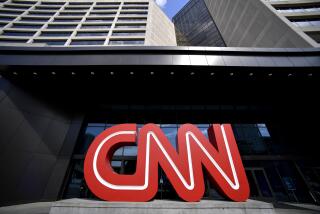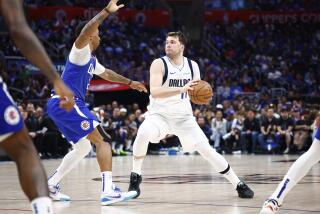ESPN to Drop Cellphone Service
- Share via
Walt Disney Co. said Thursday that it would abandon one of its major new media experiments, ending the short but expensive life of a premium-priced cellular phone service sold by its ESPN division.
Launched late last year and promoted heavily with Super Bowl advertising and during ESPN shows, Mobile ESPN provided access to sports scores, statistics and video highlights.
What the phone did not have in great number were customers. ESPN wouldn’t say how many it had signed up, but it dropped the upfront price of $499 early on to spur demand. A Merrill Lynch & Co. analyst in July cut her projection for subscribers during the fiscal year ending this week to 30,000, from 240,000. Disney’s goal had been to eventually reach 3 million customers.
Merrill Lynch analyst Jessica Reif Cohen estimated Thursday that Disney had spent $100 million to get the phones to market. That would put ESPN’s cost for 30,000 customers at more than $3,000 a head.
“We built a great application,” said Salil Mehta, executive vice president of ESPN Enterprises. “The application was seen by, and enjoyed by, a small niche of the market.” About 9 in 10 customers personalized their phones for quicker access to favorite teams or players, Mehta said.
A spokeswoman said Disney was plowing ahead with its own branded phone aimed at parents who want to keep control of their children’s cellular use. Both the Disney and the ESPN phones come with monthly cellular service from Sprint Nextel Corp. that the company bought in bulk.
Some experts criticized the approach, saying the ESPN experience showed how difficult the “mobile virtual network operator,” or MVNO, market can be even for a huge company.
“Disney must focus on the content business, distribute it across all networks and forget the MVNO business,” said John Strand of Strand Consult in Copenhagen.
Others urged patience. “You need the right handsets for the right customers with the right plans at the right prices and the right message to people,” said Thad Langford, Sprint’s vice president for strategic partners. “You’re not going to be achieving success overnight.”
Although Europe is filled with successful MVNO ventures, the U.S. market has only a few, led by Virgin Mobile USA and its 4 million subscribers.
ESPN executives knew three years ago that the project would be challenging, said an early advisor, Ranjan Mishra of Mercer Management Consulting in Boston. Fans could get their fix by ordering up-to-the-minute sports news over their cellphones from major carriers.
Mishra criticized advertising efforts for failing to explain why ESPN’s phone was better than a regular cellphone.
“You can’t assume that just because people know a brand, they know the phone,” he said.
Potential customers, Mishra said, didn’t realize from the advertising that the high price was for both a regular voice plan and a data plan that would provide scores and other sports information. ESPN is now negotiating to offer a version of its phone service for sale by existing providers. Mehta said he hoped those deals would be struck within six months.
About two-thirds of Mobile ESPN’s 100 employees will lose their jobs, a spokeswoman said. Analysts said Disney might take a charge against fourth-quarter earnings. Existing Mobile ESPN customers will get service through the end of this year and refunds on their handsets.
The demise of ESPN’s phone is a rare stumble among Disney’s recent digital experiments -- one of Chief Executive Robert Iger’s top priorities.
Disney was the first to make available network television shows and then movies on Apple Computer Inc.’s iTunes download service.
“You’ve got to give them some credit for being willing to go out and take some risk and not be stuck in the old-media slump,” said Anthony Valencia, an industry analyst with Disney shareholder Trust Co. of the West.
More to Read
The biggest entertainment stories
Get our big stories about Hollywood, film, television, music, arts, culture and more right in your inbox as soon as they publish.
You may occasionally receive promotional content from the Los Angeles Times.










